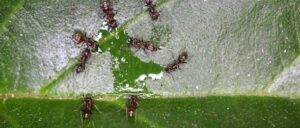Understanding the Difference Between Termites and Flying Ants
Termites and flying ants may look similar, but critical differences can help you identify and distinguish between the two pests. Let’s take a closer look at these differences:
Appearance Differences
Termites have straight antennae and wide bodies without pinched waists. They are typically black or dark brown. When termites swarm, they have clear front and back wings of the same length. On the other hand, flying ants have elbowed antennae and pinched waists. They can have bodies that are black, brown, or reddish. Flying ants have two pairs of wings; the back pair is smaller and browner in tint.
Behavior Differences
Both ants and termites in Silver Spring MD live in large colonies with designated caste systems. However, termites are often found in decaying trees, stumps, wood debris, lumber, and the wooden parts of structures. They can cause severe damage to structures as they feed on wood. On the other hand, some ants, like carpenter ants, also inhabit wood and wooden structures. However, carpenter ants do not eat wood and typically do not cause structural damage. They primarily feed on nectar, seeds, other insects, and food debris found around and inside homes.
Diet Differences
Ants are omnivores, meaning they have a varied diet. They primarily consume nectar, seeds, other insects, and food debris found in their surroundings. Termites in Northern Virgina or Maryland, on the other hand, feed on cellulose, which is a nutrient-rich material found in plants. Their primary diet consists of wood, paper, and other cellulose-based products.
Life Cycle Differences
Ants go through four stages of development: egg, larva, pupa, and adult. Worker ants have a lifespan of a few months, while queens can live for years. In contrast, the termite life cycle includes egg, nymph (larvae), and adult phases. Most termites have a lifespan of a couple of years, while termite queens can live for several decades.
Reproductive Cycle
Both ants and termites have similar reproductive cycles. During the warmer months, winged ants and termites fly from their nests to mate and establish new colonies. In ant species, the male partners usually die after mating with the females. After mating, male and female termites continue to live on and expand their new colonies. Both ants and termites shed their wings after mating.
Conclusion
Understanding the differences between termites and flying ants is essential to adequately identify and address a pest infestation. By knowing their appearance, behavior, diet, life cycle, and reproductive habits, you can take the necessary steps to protect your home from damage and effectively eliminate pests. It is always recommended to consult with a professional pest control expert for accurate identification and treatment.
Rest Easy Tonight
We’ll get rid of your pests safely, effectively, and immediately.
CALL NOW FOR YOUR FREE ESTIMATE – (301) 613-6570
 When it comes to Termites VS Flying Ants in DC or Northern Virgina, many homeowners first notice a swarm of flying insects. But not all flying insects are termites – some are flying ants. Northern Virgina Pest control experts can help differentiate between these two pests based on their physical traits. Identifying the differences between ants and termites is essential for effective pest control.
When it comes to Termites VS Flying Ants in DC or Northern Virgina, many homeowners first notice a swarm of flying insects. But not all flying insects are termites – some are flying ants. Northern Virgina Pest control experts can help differentiate between these two pests based on their physical traits. Identifying the differences between ants and termites is essential for effective pest control.